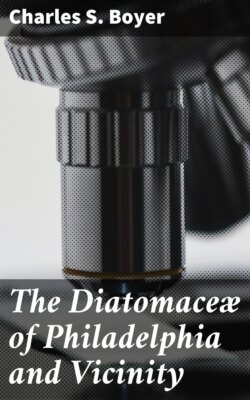Читать книгу The Diatomaceæ of Philadelphia and Vicinity - Charles S. Boyer - Страница 24
На сайте Литреса книга снята с продажи.
Cyclotella Kuetz. (1833)
Оглавление(cyclos, a circle)
Frustules single or geminate, cylindrical, short, in zone view rectangular or with undulating sides. Valve usually with smooth or punctate striæ, centre sometimes bullose, smooth, or with granules scattered or radiating.
Chromatophores numerous along the valves (Pfitzer).
CYCLOTELLA STRIATA (KUETZ.) GRUN.
Valve 30-80 µ in diam., with coarse striæ, 7-12 in 10 µ, centre coarsely punctate and bullose.
Coscinodiscus striatus Kuetz.
Cyclotella dallasiana Wm. Sm.
Common in the blue clay.
Pl. 2, Fig. 9.
CYCLOTELLA MENEGHINIANA KUETZ.
Frustule in zone view rectangular, undulated; valve, 10-20 µ in diam., marginal striæ robust and transversely punctate, centre radiately punctate.
Cyclotella kuetzingiana Wm. Sm. (not Thwaites).
Crum Creek.
Pl. 2, Fig. 8.
CYCLOTELLA MENEGHINIANA, VAR. STELLIGERA CL. AND GRUN.
Differs from the type in the coarse radiating lines at the centre.
Broomall Lake, Media.
Pl. 2, Fig. 4.
CYCLOTELLA MENEGHINIANA, VAR. STELLULIFERA CL. AND GRUN.
As in type but with the central rays granulate.
Broomall Lake, Media.
Pl. 2, Fig. 12.
CYCLOTELLA STYLORUM (BR.?) V. H.
Margin striated, the alternate striæ thickened near the border, producing an appearance of subquadrate cells. Centre faintly granulate, the outer border of which is encircled by 10-12 puncta, each of which is surrounded by a small hyaline space.
Blue clay. Rare.
Van Heurck gives this form doubtfully as a variety of striata, while De Toni makes it synonymous with it. Van Heurck's figure is not that of Brightwell, but as the specimen above described is, I believe, exactly the same as Van Heurck's, I retain his name.
Pl. 2, Fig. 10.
CYCLOTELLA COMTA (EHR.) KUETZ.
Valve with marginal striæ well marked, each third or fourth costa more robust than the others. Central part finely striated, the striæ punctate, radiating.
Fresh water.
Pl. 2, Fig. 7.
The form here figured is probably the variety radiosa Grun. and is from a New England specimen. It is quite likely to occur in this locality.
CYCLOTELLA OPERCULATA (AG.) KUETZ.
Frustules in zone view undulated. Angles rounded. Marginal costæ alternating with minute spines; centre nearly smooth, depressed, convex or flexuose.
Fresh water.
Pl. 2, Figs. 5 and 6.
The figure is drawn from a specimen from Boston, Mass., H. L. Smith Type Slide No. 107, marked equivalent to C. minutula Wm. Sm.
CYCLOTELLA ANTIQUA WM. SM.
Marginal costæ alternating with thick puncta; centre finely granulate with subtriangular elevations. Frustules in zone view rectangular.
Blue clay.
Pl. 2, Fig. 11.
The form corresponds to the original specimens of Wm. Smith in the deposit of Stavenger, Norway.
The genus Cyclotella comprises about seventy specific names, many of which may be referred to other genera, while some of Ehrenberg's are incapable of verification on account of the small size of the figures and the lack of sufficient description. About half of the forms are marine. The fresh-water species are usually found living in more or less stagnant water or in pools contaminated with drainage, being an exception to the general rule that diatoms are more abundant in water free from deleterious matter.
